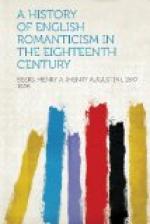this caprice and absurdity in them? Or may there
not be something in the Gothic Romance peculiarly
suited to the view of a genius and to the ends of poetry?
And may not the philosophic moderns have gone too
far in their perpetual ridicule and contempt of it?”
After a preliminary discussion of the origin of chivalry
and knight-errantry and of the ideal knightly characteristics,
“Prowess, Generosity, Gallantry, and Religion,”
which he derives from the military necessities of
the feudal system, he proceeds to establish a “remarkable
correspondency between the manners of the old heroic
times, as painted by their romancer, Homer, and those
which are represented to us in the books of modern
knight-errantry.” He compares,
e.g.,
the Laestrygonians, Cyclopes_,
Circes, and Calypsos
of Homer, with the giants, paynims, sorceresses encountered
by the champions of romance; the Greek aoixoi with
the minstrels; the Olympian games with tournaments;
and the exploits of Hercules and Theseus, in quelling
dragons and other monsters, with the similar enterprises
of Lancelot and Amadis de Gaul. The critic is
daring enough to give the Gothic manners the preference
over the heroic. Homer, he says, if he could
have known both, would have chosen the former by reason
of “the improved gallantry of the feudal times,
and the superior solemnity of their superstitions.
The gallantry which inspirited the feudal times was
of a nature to furnish the poet with finer scenes
and subjects of description, in every view, than the
simple and uncontrolled barbarity of the Grecian. .
. There was a dignity, a magnificence, a variety
in the feudal, which the other wanted.”
An equal advantage, thinks Hurd, the romancers enjoyed
over the pagan poets in the point of supernatural
machinery. “For the more solemn fancies
of witchcraft and incantation, the horrors of the Gothic
were above measure striking and terrible. The
mummeries of the pagan priests were childish, but
the Gothic enchanters shook and alarmed all nature.
. . You would not compare the Canidia of Horace
with the witches in ‘Macbeth.’ And
what are Virgil’s myrtles, dropping blood, to
Tasso’s enchanted forest?. . . The fancies
of our modern bards are not only more gallant, but
. . . more sublime, more terrible, more alarming than
those of the classic fables. In a word, you
will find that the manners they paint, and the superstitions
they adopt, are the more poetical for being Gothic.”
Evidently the despised “Gothick” of Addison—as
Mr. Howells puts it—was fast becoming the
admired “Gothic” of Scott. This pronunciamento
of very advanced romantic doctrine came out several
years before Percy’s “Reliques”
and “The Castle of Otranto.” It was
only a few years later than Thomas Warton’s
“Observations on the Faerie Queene” and
Joseph’s “Essay on Pope,” but its
views were much more radical. Neither of the
Wartons would have ventured to pronounce the Gothic
manners superior to the Homeric, as materials for




